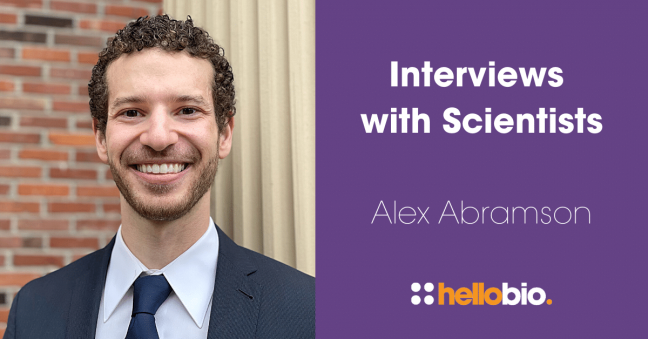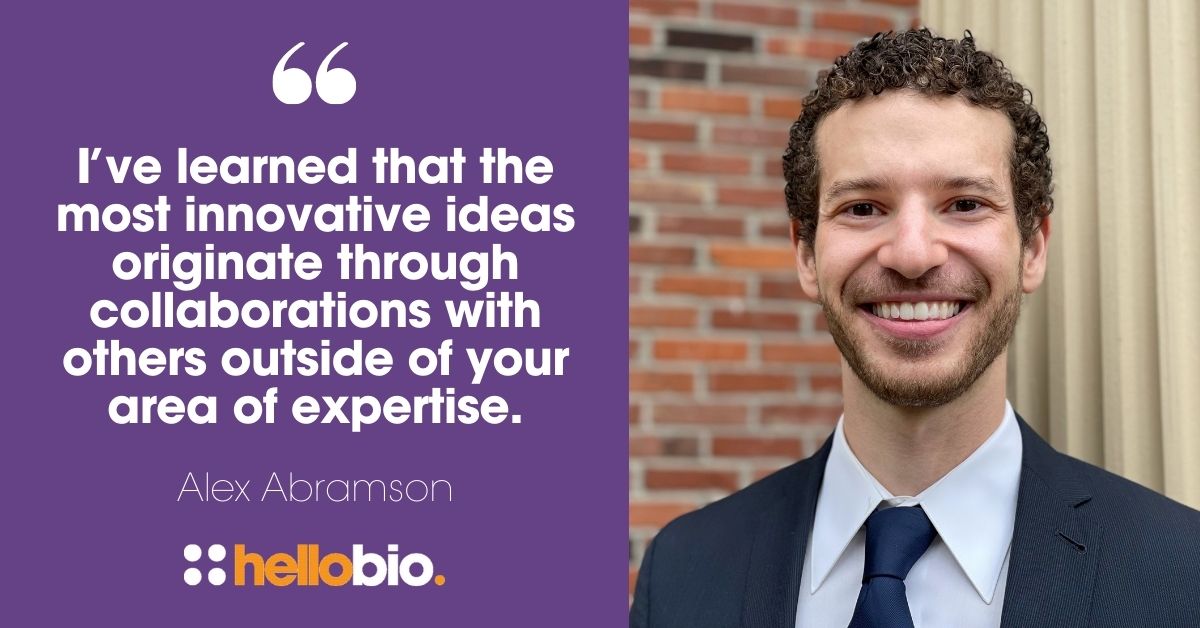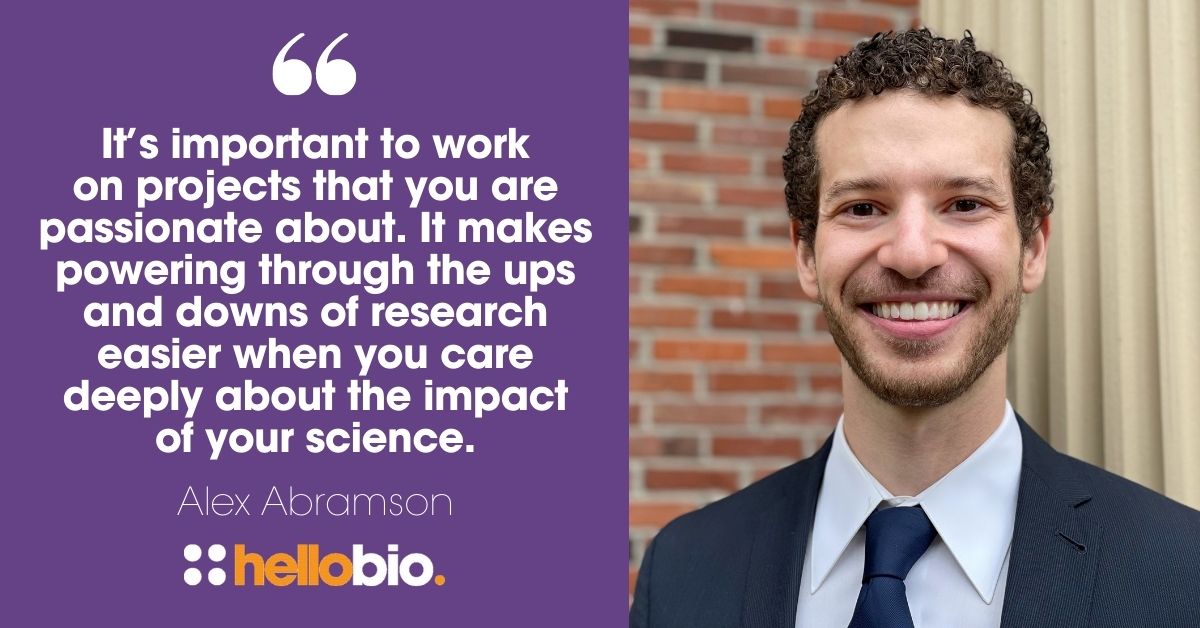Interviews with Scientists: Alex Abramson
In the next in our Interviews with Scientists series we spoke with Dr. Alex Abramson, a postdoctoral fellow in Chemical Engineering at Stanford University, USA.
Alex received his B.S. in Chemical and Biomolecular Engineering from Johns Hopkins University and his Ph.D. in Chemical Engineering from MIT under the direction of Profs. Robert Langer and Giovanni Traverso. His research, which focuses on oral biologic drug delivery and bioelectronic therapeutics, has been featured in news outlets such as The New York Times, NPR, and Wired. He has received several recognitions for scientific innovation, including being named a member of the Forbes 30 Under 30 Science List and being named an NIH Ruth L. Kirschstein Postdoctoral Fellow.
Alex will join Georgia Tech as an Assistant Professor of Chemical and Biomolecular Engineering in August 2022. He is passionate about translating scientific endeavours from bench to bedside. Recently, Novo Nordisk exclusively licensed a portfolio of his patents to bring into clinical trials, and Alex serves as a scientific advisor overseeing their commercialization.
We had a fascinating chat with Alex who told us more about his innovative design for a new oral drug delivery system, his passion for multi-disciplinary collaboration, and his future research plans…
Thanks for speaking with us, Alex! Please can you tell us a little bit about your current role at Stanford University?
Currently, I am a postdoctoral fellow in Chemical Engineering at Stanford University working with Profs. Zhenan Bao and the late Sanjiv S. Gambhir. I work in the field of bioelectronics, and I develop wearable and implantable sensors to monitor chronic diseases. For example, I recently developed a wearable sensor that can detect the real-time regression of primary tumors following initiation of a new treatment. Because the sensor reads out continuously, we can use it in small animal models to detect the short-term pharmacodynamic effects of drugs and even spot tumor regression within the first few hours of treatment initiation.
What excites you most about the work that you do?
I love the day-to-day problem solving associated with developing new medical devices, but the thing that excites me the most about my work is the potential impact it could have on patients worldwide. Before beginning any project, I delve into health decision analysis studies to determine how a potential innovation could impact a patient’s health outcomes and quality of life. This practice helps guide my engineering design choices to better align with the healthcare system, and it provides a powerful motivation to go to work every day.
Your work on oral biologic drug delivery has reached clinical trial stage. Can you tell us a little more about it?
Imagine if you could replace a vaccine jab or an insulin shot with a pill. My invention is an orally dosed capsule capable of delivering drugs that otherwise needs to be injected without compromising on cost or effectiveness. Without the aid of my pill, biologic drugs such as proteins and nucleic acids are rapidly degraded by enzymes present in the gastrointestinal tract, and the molecules are too large to pass through the tight junctions of the tissue wall. Once ingested, my pill falls to the bottom of the stomach and reorients itself like a weeble-wobble toy to face the tissue wall. It then painlessly inserts the drug directly into the tissue.
What have been the biggest challenges you and your colleagues have faced along this journey?
For the pill to work reliably, the needle injection system must always face the tissue wall. My pill design takes inspiration from the leopard tortoise, which can easily reorient itself when tipped over. Just like my pill, its shell only has one local and global minimum for its center of mass, meaning it only has one stable configuration. The pill and shell have pointed tops to destabilize unpreferred configurations and weighted and flat bottoms to ensure that outside forces (e.g. stomach contractions) don’t tip them over once upright. Using the shell as a guide, I computationally optimized the pill shape for self-righting in the stomach.
Where do you hope your research will lead, and what impact could your work have on the future of drug delivery?
Biologic drugs are generally regarded as one of the most efficacious modalities for the treatment of a range of diseases, such as diabetes and Crohn’s disease. Nevertheless, their requirement for injection-based administration often causes healthcare professionals to delay their initiation (e.x. insulin initiation is delayed an average of 7.7 years in favor of less effective oral medications). I collaborated with the Harvard School of Public Health to develop a model that suggested my pills could provide an additional quality adjusted life-year and >$100,000 in value for every patient that switched away from injection-based administration.
Did you always want to work in science when you were younger, and if so why?
I always enjoyed my science classes as a kid, but I had no idea what scientists really did until I went to college and spent my sophomore year working in an academic lab. That experience opened my eyes to the excitement and impact that working on a completely new problem could provide. I fell in love with scientific research immediately and knew that I wanted to pursue it as a career.
What's the most important lesson you have learned in your career so far?
I’ve learned that the most innovative ideas originate through collaborations with others outside of your area of expertise. I’ve had the opportunity to work in laboratory environments where scientists from widely differing backgrounds work together to create new ideas, and I’ve also had the experience of working side-by-side on a collaborative project between academia and industry. Everyone brings a distinct set of tools to the table, and it makes overcoming project hurdles much easier when everyone approaches the problems with a unique point of view.
How do you see your career developing in the future/where do you see yourself in 10 years?
I will be starting as a tenure track Assistant Professor at Georgia Tech in the School of Chemical and Biomolecular Engineering starting August 2022. My lab will focus on developing smart drug delivery devices that improve patient compliance and provide better tissue level targeting to prevent off-target side effects. We will be developing bioelectronic pills, patches and implants to treat a wide range of the world’s most pressing diseases.
Who has been your greatest role model, and why?
My biggest role models have been my PhD and Postdoc Advisors, Robert Langer, Zhenan Bao, and Gio Traverso. Not only do they make an impact on society through their own research, but they are also passionate about training the next generation of scientists on how to make an impact as well.
What key piece of advice would you give to a young scientist just starting out in their career?
It’s important to work on projects that you are passionate about. It makes powering through the ups and downs of research easier when you care deeply about the impact of your science.
Outside of your career, what do you enjoy doing most? (e.g. hobbies, passion projects, etc.)
I love to be outdoors, and I can regularly be found hiking, biking, and playing golf. I’m also a huge fan of movies, anything from arthouse cinema to big budget spy thrillers.
__________________________________________
Thank you so much for chatting with us Alex! We wish you all the best with your future research.
Connect with Alex:
- Website: www.agabramson.com
- Twitter: @agabramson
- LinkedIn: Alex Abramson
__________________________________________
If you enjoyed this article, why not check out the other resources available on our blog. We are passionate about supporting life scientists including early career life scientists and PhD students - with really low-priced reagents and biochemicals, early career scientist grants, and resources to help with both personal and professional development. We know how tough it is - so we hope you find these helpful!
More General Support for Life Scientists
For advice on writing papers, dissertations, presenting at conferences, wellbeing, PhD support, networking and lots more, we have a huge range of articles to help - just click below:
Save up to 50% on our high purity reagents...
When you get to the stage of planning your experiments, don't forget that we offer a range of low-cost, high-purity agonists, antagonists, inhibitors, activators, antibodies and fluorescent tools (yes - they really are around half the price of other suppliers!) You can use our Quick Multi-Search Tool to search for lots of products in one go, and the range includes:
- Enzyme inhibitors and activators
- Chemogenetic ligands
- Ion channel modulators
- GPCR & ionotropic receptor ligands
- Cell biology reagents & biochemicals
Technical resources
Try our Molarity Calculator: a quick and easy way to calculate the mass, volume or concentration required for making a solution.
Try our Dilution Calculator: an easy way to work out how to dilute stock solutions of known concentrations
And finally, don't forget to check back in with our blog regularly for our latest articles. If there’s something you’d love to contribute to the community, whether that’s an interview or article, drop us a line at hello@hellobio.com
---



















